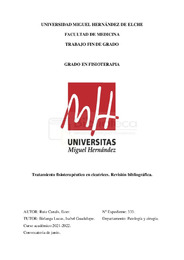Por favor, use este identificador para citar o enlazar este ítem:
https://hdl.handle.net/11000/28161Registro completo de metadatos
| Campo DC | Valor | Lengua/Idioma |
|---|---|---|
| dc.contributor.advisor | Birlanga Lucas, Isabel Guadalupe | - |
| dc.contributor.author | Ruiz Canals, Ester | - |
| dc.contributor.other | Departamentos de la UMH::Patología y Cirugía | es_ES |
| dc.date.accessioned | 2022-11-02T12:48:23Z | - |
| dc.date.available | 2022-11-02T12:48:23Z | - |
| dc.date.created | 2022-06-20 | - |
| dc.identifier.uri | https://hdl.handle.net/11000/28161 | - |
| dc.description.abstract | Introducción: una cicatriz ocurre cuando se interrumpe la continuidad de la piel, entonces se produce el proceso de cicatrización que se encarga de devolverle esa continuidad e integridad anatómica a la piel. Este proceso de cicatrización puede desencadenar varios tipos de cicatrices: inmaduras, maduras, atróficas, hipertróficas, queloides y contracturadas. Algunos de estos tipos necesitan tratamiento fisioterapéutico para mejorar el prurito, el dolor, la flexibilidad, la vascularización y la altura de la cicatriz. Objetivos: Realizar una búsqueda bibliográfica para conocer el tratamiento fisioterapéutico en cicatrices. Material y método: Se realizó una búsqueda bibliográfica en las bases de datos PubMed, ScienceDirect., PEDro, Embase y Google scholar de artículos publicados en los últimos diez años. Resultados: Se obtuvieron 13 artículos que cumplían todos los requisitos del estudio, encontrando 6 tipos de intervenciones (láser, ondas de choque, ultrasonido, parafina, crioterapia y terapia manual). Cada artículo estudiaba un tipo de cicatriz diferente, 7 eran sobre quemaduras, 1 sobre cesárea, 1 sobre mastectomía, 1 sobre endometriosis, 1 sobre biopsia del ganglio centinela, 1 sobre cicatrices hipertróficas y 1 sobre cicatrices antiguas. Conclusión: A pesar de que falta más investigación en esta área y por ello no hay ningún protocolo estandarizado, hemos observado que en la mayoría de los artículos encontrados hay mejoras significativas en los diferentes tipos de intervenciones. | es_ES |
| dc.description.abstract | Introduction: a scar occurs when the continuity of the skin is interrupted, then the healing process takes place which is responsible for restoring that skin continuity and anatomical integrity. This healing process can cause several types of scars: immature, mature, atrophic, hypertrophic, keloid and contracted. Some of these types require physiotherapeutic treatment to improve itching, pain, flexibility, vascularity, and scar height. Objectives: To conduct a literature search in order to learn about the physiotherapeutic treatment of scars. Material and methods: A literature search was carried out in the PubMed, ScienceDirect., PEDro, Embase and Google scholar databases of articles published in the last ten years. Results: We obtained 13 articles that met all the requirements of the study and we found 6 types of interventions (laser, shock wave, ultrasound, paraffin, cryotherapy and manual therapy). Each article studied a different type of scar: 7 were about burns, 1 about caesarean, 1 about mastectomy, 1 about endometriosis, 1 about sentinel node biopsy, 1 about hypertrophic scars and 1 about old scars. Conclusion: Although more research is needed in this area and therefore there is no standardized protocol, we have observed that in most of the articles found there are significant improvements in the different types of interventions. | es_ES |
| dc.format | application/pdf | es_ES |
| dc.format.extent | 34 | es_ES |
| dc.language.iso | spa | es_ES |
| dc.publisher | Universidad Miguel Hernández | es_ES |
| dc.rights | info:eu-repo/semantics/openAccess | es_ES |
| dc.rights | Attribution-NonCommercial-NoDerivatives 4.0 Internacional | * |
| dc.rights.uri | http://creativecommons.org/licenses/by-nc-nd/4.0/ | * |
| dc.subject | Fisioterapia | es_ES |
| dc.subject | Cicatriz | es_ES |
| dc.subject.other | CDU::6 - Ciencias aplicadas | es_ES |
| dc.title | Tratamiento fisioterapéutico en cicatrices. Revisión bibliográfica. | es_ES |
| dc.type | info:eu-repo/semantics/bachelorThesis | es_ES |

Ver/Abrir:
TFG Ester.pdf
784,34 kB
Adobe PDF
Compartir:
 La licencia se describe como: Atribución-NonComercial-NoDerivada 4.0 Internacional.
La licencia se describe como: Atribución-NonComercial-NoDerivada 4.0 Internacional.
.png)